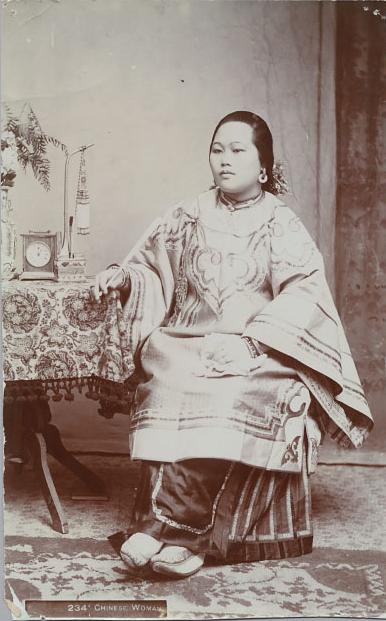The "Strangely Alluring" Ah Toy
First off, thanks to all of you who took a few minutes out of your busy day to wander over to this blog to see what I'm doing. With the exception of a few history-buff friends, it must have taken a few deep sighs, a couple eye rolls, and an exasperated "Sure, I'd LOOOOVE to read about the 1850s!" to screw up the courage to actually do so. Ms. Toy and I appreciate it, although she would have charged you an ounce of gold to take a peep at her. More on that in a future post.
Ah Toy certainly was someone beautiful to behold. I haven't come across any photographs of her, nor do I expect to, and neither have paintings, drawings, or sketches come to my attention. And don't trust the results from Google Images... they seem to think any Chinese woman will suffice. In 2010, The San Francisco Examiner wrote a short paragraph about Ah Toy and slapped this picture next to it:

But there's no proof that it's her. A little digging brings up the description of the picture, which reads, "Portrait of a married Chinese-American woman in the 1870s." Ah Toy was in her 40s in the decade of the 1870s, so it could be her, but most likely it isn't. She disappeared from the San Francisco scene in 1859 and didn't reappear until her obituary in the 1920s. If she were to take a photo like this, it probably would have been during the height of her popularity in the early 1850s, but since the caption says otherwise, I'm going with no.
Ah Toy certainly was someone beautiful to behold. I haven't come across any photographs of her, nor do I expect to, and neither have paintings, drawings, or sketches come to my attention. And don't trust the results from Google Images... they seem to think any Chinese woman will suffice. In 2010, The San Francisco Examiner wrote a short paragraph about Ah Toy and slapped this picture next to it:

But there's no proof that it's her. A little digging brings up the description of the picture, which reads, "Portrait of a married Chinese-American woman in the 1870s." Ah Toy was in her 40s in the decade of the 1870s, so it could be her, but most likely it isn't. She disappeared from the San Francisco scene in 1859 and didn't reappear until her obituary in the 1920s. If she were to take a photo like this, it probably would have been during the height of her popularity in the early 1850s, but since the caption says otherwise, I'm going with no.
Which is too bad, because it sounds like she was a real beauty. You actually didn't have to be, in those days, for men to notice you. You just had to be a woman. With over 90% of the population being male (the wives were left behind while the man left to claim his fortune), any woman was going to catch the eye and imagination of a young, virile, lonely man. So maybe Ah Toy wasn't that amazingly gorgeous, but you wouldn't know it by what some of the men said about her:
Finally, there are conflicting reports about whether or not she had bound feet. Foot binding, the now-considered-abominable Chinese practice dating back to the 11th century, was still en vogue for middle- and upper-class women in the 1800s. For Ah Toy, however, signs point to normal feet. She was likely a peasant in China, part of an ethnic group of people called Hakka (I'm still trying to verify this), who did not bind their women's feet. But the biggest hint that she didn't have bound feet comes from this newspaper story in 1851:
The first Chinese courtesan who came to San Francisco was Ah Toy. She arrived I think in 1850 and was a very handsome Chinese girl. She was quite select in her associates was liberally patronized by the white men and made a great amount of money.
Elisha Crosby, 1878
She was a tall, well-built woman. In fact, she was the finest-looking woman I have ever seen.
Charles Duane, 1881
Blooming with youth, beauty, and rouge...Ah Toy came into court...
The Daily Alta California, 12/14/1851
The Chinese are usually ugly, the women as well as the men; but there are a few girls who are attractive if not actually pretty, for example, the strangely alluring Achoy, with her slender body and laughing eyes.
Albert Benard de Russailh, 1851
It would be well for the female dress reformers in the Atlantic States to send out here for a Chinese woman as a specimen.
The Daily Alta California, 7/1/1851
Finally, there are conflicting reports about whether or not she had bound feet. Foot binding, the now-considered-abominable Chinese practice dating back to the 11th century, was still en vogue for middle- and upper-class women in the 1800s. For Ah Toy, however, signs point to normal feet. She was likely a peasant in China, part of an ethnic group of people called Hakka (I'm still trying to verify this), who did not bind their women's feet. But the biggest hint that she didn't have bound feet comes from this newspaper story in 1851:
Last evening, about eight o'clock, that portion of the city in the vicinity of the Plaza was aroused by a certain nondescript noise.... When we arrived near the spot whence the outcry was proceeding, we found her in full chase after a suspicious looking individual, who had the appearance of being a volunteer to the Indian War. The thief kept ahead for a time, but Atoy was too swift for him, seized him by the collar very much in the style of a police officer, and demanded a diamond pin which he and his party had taken away from her.
The Daily Alta California, 12/11/1851
No foot-bound woman could have moved like that!
Comments
Post a Comment